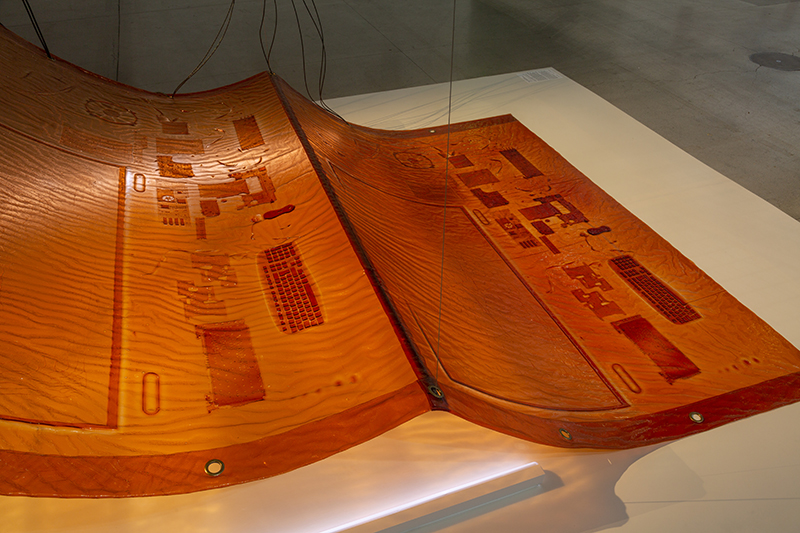Membranes in action: multidisciplinary creation of sustainable interfaces between communities, ecological milieux and the built environment
Research Team
Dr. Alice Jarry
Dr. Samuel Bianchini
Dr. Marie-Pier Boucher
Delfina Fantini Van Ditmar
Dr. Aurélie Mosse
Dr. Philippe Pais
Dr. Miranda Smitheram
Brice Ammar-Khodja
Alexandra Bachmayer
Didier Bouchon
Theo Chauvirey
Maria Checkhanovich
Matthew Halpenny
Raphaëlle Kerbrat
Annie Leuridan
Vanessa Mardirossian
Asa Perlman
Philippe Vandal
Lucille Vareilles
Funding
SSHRC



Fossilation, installation. Centre Pompidou, 2021 (Curator: Géraldine Gomez). Photo: Samuel Bianchini
At the crossroads of design, digital art and media studies, this research-creation project experiments with flexible and reactive artistic objects inspired by living systems. A membrane is a flexible and metabolic surface at the interface of materials, liquids and/or gases.
Through their ability to transform, these surfaces make visible the permeable border between living beings and the environment, thus demonstrating that humans and the ecosystem they inhabit co-constitute.
The research examines how the operative concept of “membrane” can give rise to new forms of lasting interactions between materiality, technology, humans and ecological milieux.
By creating flexible membranes that interact with humans and the environment in public spaces, the project explores how the adaptive processes of filtration, circulation, protection and ‘elasticization’ can induce new aesthetic, sensory, and critical relationships with the built environment.
Through their ability to transform, these surfaces make visible the permeable border between living beings and the environment, thus demonstrating that humans and the ecosystem they inhabit co-constitute.
The research examines how the operative concept of “membrane” can give rise to new forms of lasting interactions between materiality, technology, humans and ecological milieux.
By creating flexible membranes that interact with humans and the environment in public spaces, the project explores how the adaptive processes of filtration, circulation, protection and ‘elasticization’ can induce new aesthetic, sensory, and critical relationships with the built environment.
The membrane is approached as both an object, a concept and a methodology that allows exchanges at the interface of materials, technologies, audiences and research in art and science.
‘Membranes in Action’
contributes to the fields of bio-media and architecture to address the socio-political and technological relationships that link humans to ecosystems. In the era of so-called "smart" materials, ‘Membranes in Action’ contributes to the discourse on cultural and material production in art and design and develops innovative technological devices and reflective tools that respond to current and future socio-environmental challenges.
‘Membranes in Action’
contributes to the fields of bio-media and architecture to address the socio-political and technological relationships that link humans to ecosystems. In the era of so-called "smart" materials, ‘Membranes in Action’ contributes to the discourse on cultural and material production in art and design and develops innovative technological devices and reflective tools that respond to current and future socio-environmental challenges.

Fossilation is a bioplastic membrane and an apparatus capturing the residual energy of the Centre Pompidou as it interacts with light. Photos: Samuel Bianchini





